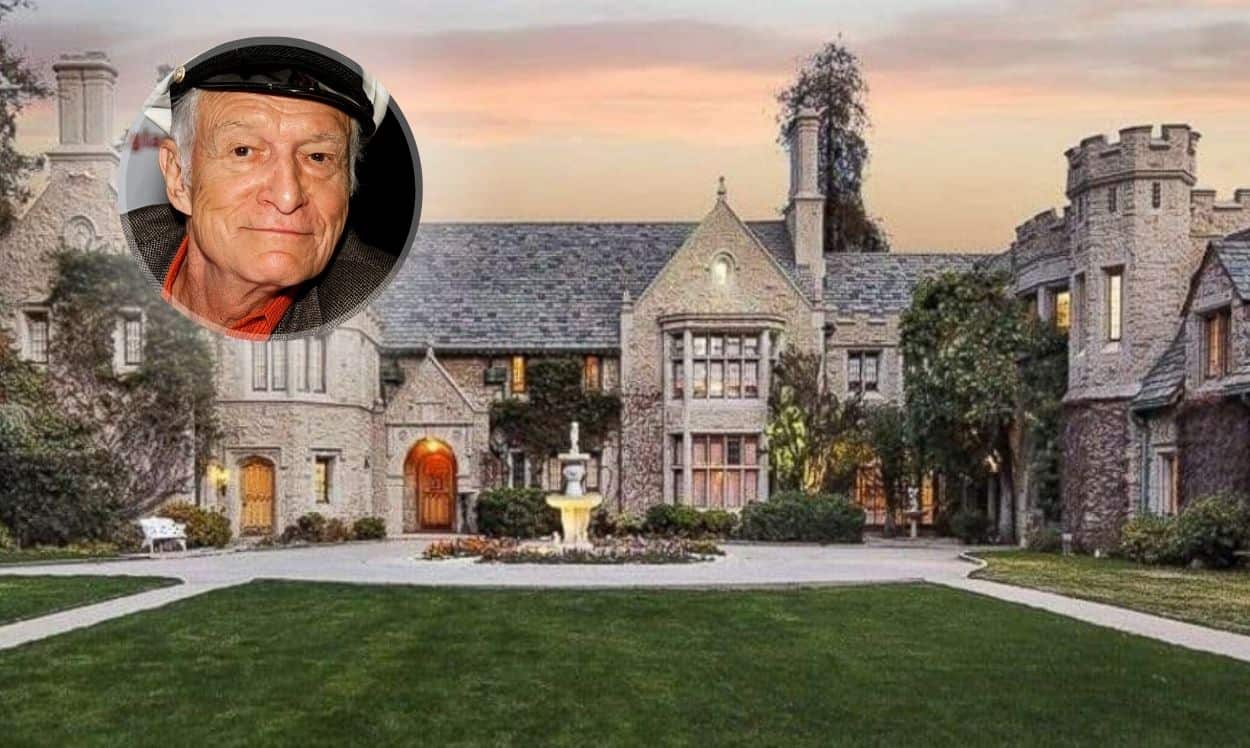
The Playboy Mansion, nestled in the affluent Holmby Hills neighborhood of Los Angeles, is more than just a luxurious residence; it is an iconic symbol of the Playboy brand and the extravagant lifestyle of its founder, Hugh Hefner. With its storied history, opulent features, and infamous parties, the mansion has become a cultural landmark, epitomizing the glamour and decadence of Hollywood’s golden age.
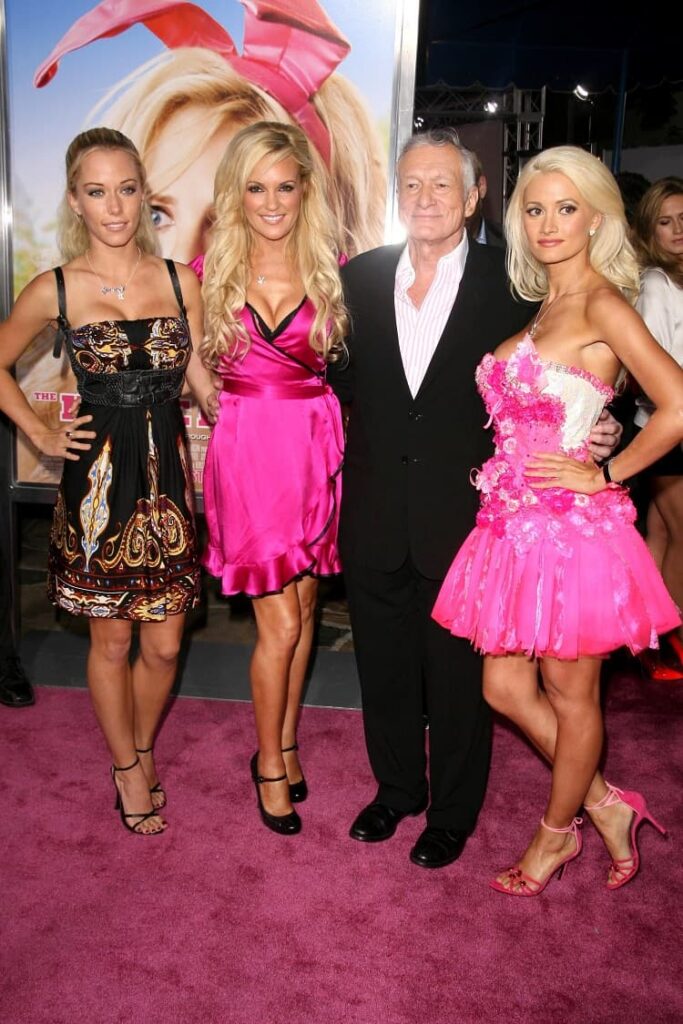
A Historic Purchase
Hugh Hefner purchased the Gothic-Tudor style mansion in 1971 for $1.1 million. Built in 1927, the mansion spans over 20,000 square feet and sits on five acres of prime real estate. From the moment Hefner acquired the property, it became the epicenter of the Playboy empire, hosting some of the most talked-about parties in history.
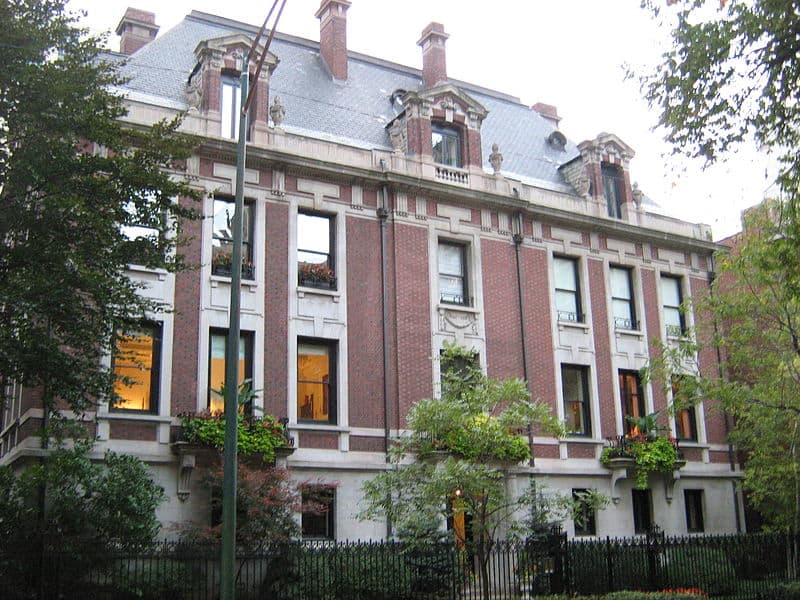
Opulent Features
The Playboy Mansion boasts an array of luxurious amenities that contribute to its legendary status. The estate features 29 rooms, including a grand ballroom, a game room, and several guesthouses. One of the most famous features is the mansion’s grotto, a hidden cave-like pool area complete with waterfalls and Jacuzzis, which has been the backdrop for countless celebrity gatherings and private parties.
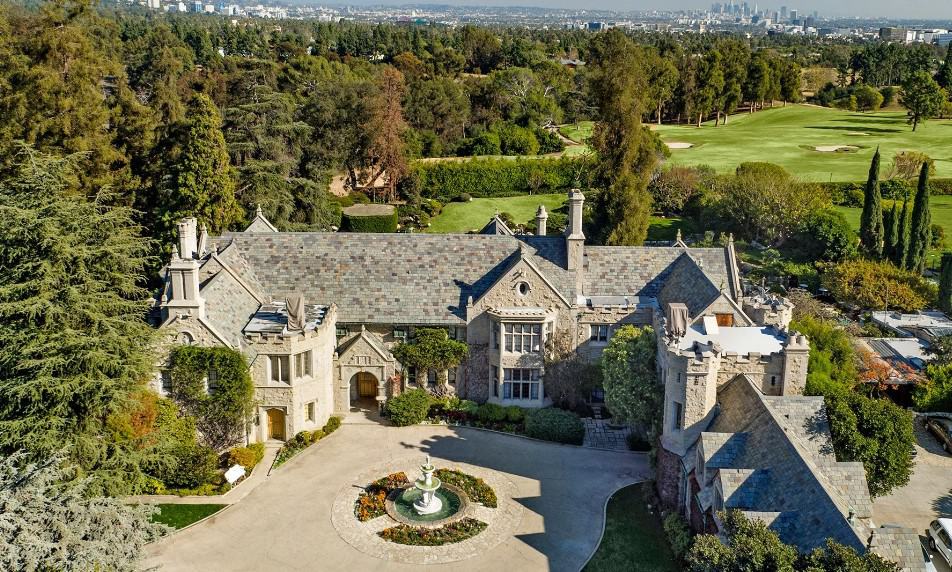
The grounds also include a tennis court, a zoo and aviary, and extensive gardens. The mansion’s wine cellar, reputedly one of the best-stocked in the world, adds to the opulence. Inside, the mansion is adorned with lavish décor, including antique furnishings, intricate woodwork, and art collections that reflect Hefner’s taste for the finer things in life.
Iconic Parties
The Playboy Mansion is perhaps best known for its extravagant parties, which attracted Hollywood’s elite, top models, and influential figures from various industries. Events like the Midsummer Night’s Dream party and the Halloween bash became annual highlights, known for their opulent themes, elaborate costumes, and star-studded guest lists. These parties were not only social events but also helped to cement Playboy’s image as a brand synonymous with luxury and indulgence.
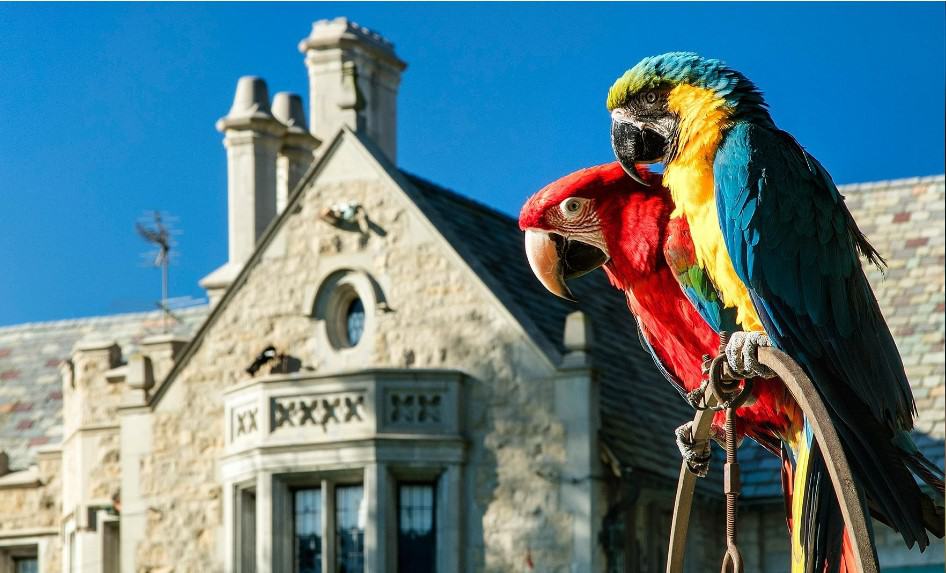
Cultural Impact
Beyond the glitz and glamour, the Playboy Mansion played a significant role in the cultural landscape. It was a place where social norms were challenged, and a new era of sexual liberation was celebrated. The mansion was not just a party venue but a gathering place for intellectuals, artists, and activists. Hefner used the space to host discussions on civil rights, free speech, and sexual freedom, reinforcing Playboy’s role as a progressive voice in society.
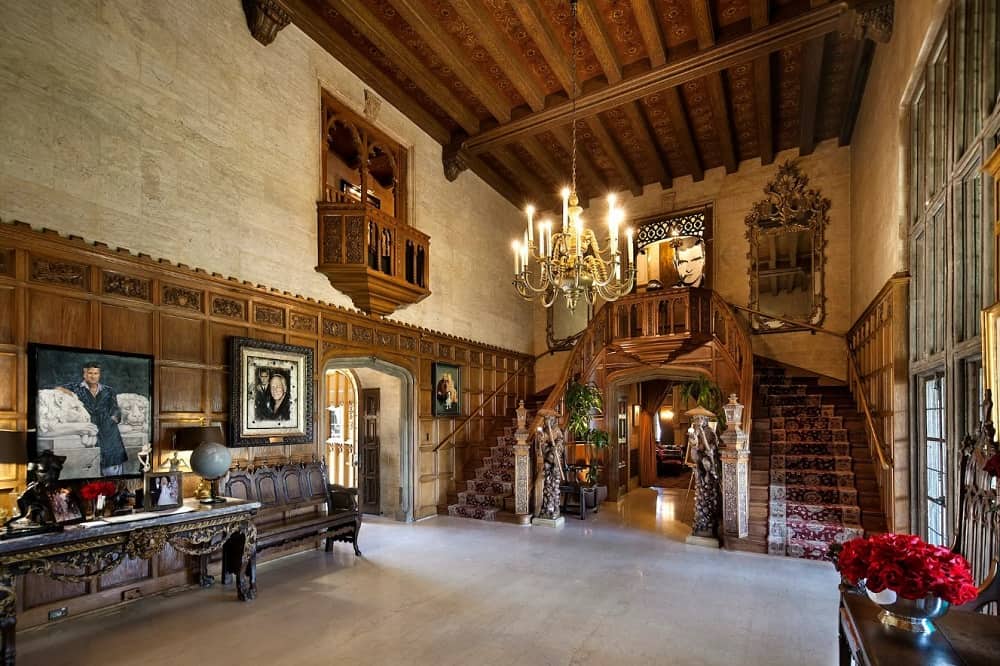
The Legacy Continues
Hugh Hefner lived in the mansion until his death in 2017, after which the estate was sold for $100 million to Daren Metropoulos, a businessman and neighbor. The sale included an agreement that Hefner could continue to live in the mansion until his passing. Today, while the future of the mansion remains uncertain, its legacy as a cultural icon endures.
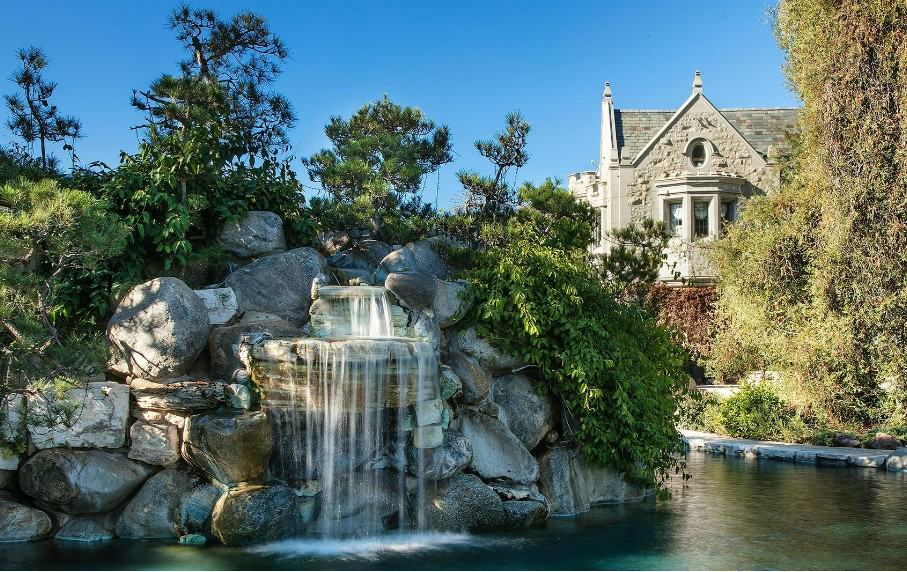
The Playboy Mansion stands as a testament to Hugh Hefner’s vision and the Playboy brand’s impact on popular culture. It remains a symbol of opulence, freedom, and the enduring allure of a bygone era of Hollywood excess. The full story of the mansion is one of glamour, controversy, and undeniable influence, capturing the imagination of generations.
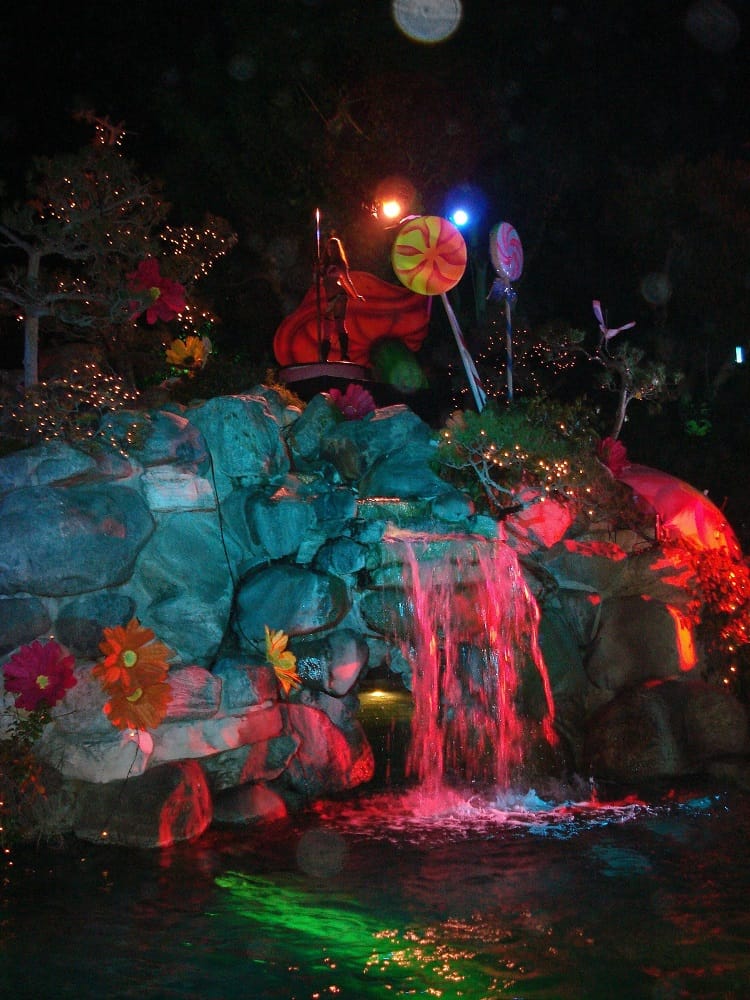
I cannot thank you enough for the article.Much thanks again. Want more.
ivermectin tablets order generic ivermectin cream
Enjoyed examining this, very good stuff, thankyou . “Shared joys make a friend, not shared sufferings.” by Friedrich Wilhelm Nietzsche.
Thanks again for the blog.Thanks Again. Will read on
free credit ck credit experian credit report free credit score
Thanks for every other magnificent article. Where elsecould anyone get that kind of information in such a perfectmeans of writing? I have a presentation next week, and I’m on the search for such info.
Thanks for finally talking about > Autumn Skincare and Beauty Essentials – Saved by Style
Hey, thanks for the blog post.Much thanks again. Want more.
Thank you for your blog post. Fantastic.
Major thankies for the blog post.Really looking forward to read more. Want more.
I value the blog. Great.
Thanks a lot for the blog article. Want more.
Im thankful for the post.Much thanks again. Really Cool.
What’s Happening i am new to this, I stumbled upon this I have foundIt absolutely useful and it has aided me out loads.I hope to give a contribution & help differentcustomers like its helped me. Great job.
Great, thanks for sharing this article post.Really looking forward to read more.
Say, you got a nice post.Much thanks again.
Very informative article. Really Cool.
Im thankful for the blog post.Really looking forward to read more. Cool.
Good day! Do you know if they make any plugins to protect against hackers? Rosamund Brian Zaslow
A round of applause for your article.Really thank you!
Thanks so much for the article post.Really looking forward to read more. Want more.
Thanks again for the article.Really looking forward to read more. Want more.
I am really impressed with your writing skills aswell as with the layout on your blog. Is this a paid theme or did you modify it yourself?Either way keep up the excellent quality writing, it is rareto see a nice blog like this one today.
Hello! I simply would like to offer you a big thumbs up for the great information you have got here on this post. I will be coming back to your blog for more soon.
Can anyone in a position to recommend good Health And Safety Training B2B Mailing List? Thanks 🙂
I also conceive therefore, perfectly pent post!my blog post virtualchurchcamp.com
That is a really good tip especially to those new to the blogosphere. Simple but very precise informationÖ Thank you for sharing this one. A must read post!
Hey there! I simply would love to give a huge thumbs up for the terrific info you have here on this article. I will certainly be returning to your blog for more quickly.
Im grateful for the blog post.Thanks Again. Really Great.
dapoxetine for premature ejaculation reviews
Enjoyed every bit of your post.Really looking forward to read more. Really Great.
artvin hava durumu 15 günlük; artvin için hava durumu en güncel saatlik, günlük ve aylık tahminler.
I value the blog article.Thanks Again.
Hi, its pleasant article regarding media print, we all know media is a impressive source of facts.
ivermectin treatment for lyme disease ivermectin for pinworms in humans
Really informative blog article.Thanks Again. Want more.
I appreciate you sharing this article post.Thanks Again. Will read on…
I really enjoy the blog article.Really thank you! Awesome.
I really like and appreciate your blog.Much thanks again. Great.
Great blog. Awesome.
Thank you ever so for you article.Really thank you! Really Cool.
I value the article.Really thank you! Awesome.
Howdy! I’m at work surfing around your blog from mynew iphone 4! Just wanted to say I love reading through your blog and look forward to allyour posts! Keep up the excellent work!
coreg hyperkalemia amiodarone panel lasix ufsurgery
I truly appreciate this post.Really thank you! Much obliged.
Hey, thanks for the article.Really thank you! Really Great.
Appreciate you sharing, great post.Much thanks again. Much obliged.
Say, you got a nice article post.Really looking forward to read more. Awesome.
Major thanks for the blog article.Much thanks again. Want more.
Very neat blog post.Really looking forward to read more. Really Cool.
Thank you for your blog. Keep writing.
I really enjoy the blog post.Really thank you! Great.
Really appreciate you sharing this article post.Much thanks again. Much obliged.
cbd near me cbd oil online cbd oil online cbd gummies walmart
I loved your post.Much thanks again. Great.
I really like and appreciate your blog.
Wow, great article post. Keep writing.
Thank you for your article post. Fantastic.
Fantastic article post.Really thank you! Really Cool.
Enjoyed every bit of your post.Much thanks again.
Very neat article post.Thanks Again.
Hey, thanks for the article. Really Great.
I’m not sure where you’re getting your info, but goodtopic. I needs to spend some time learningmuch more or understanding more. Thanks for magnificentinformation I was looking for this info for my mission.
I think this is a real great article post. Will read on…
I don’t even know the way I ended up here, however I believed this publish used to be great. I don’t recognise who you might be however certainly you are going to a well-known blogger in case you are not already. Cheers!
Wow, great article post.Thanks Again. Keep writing.
Hi, for all time i used to check blog posts here in the early hours in the morning, as i love to gain knowledge of more and more.
Hello, you used to write fantastic, but the last several posts have been kinda boring¡K I miss your super writings. Past several posts are just a bit out of track! come on!
I am so grateful for your blog article. Cool.
Im obliged for the blog article.Really looking forward to read more. Great.
Very informative article.Really thank you! Keep writing.
I appreciate you sharing this article. Keep writing.
Thanks for sharing, this is a fantastic article post.Really looking forward to read more. Will read on…
These kind of post are always inspiring and I prefer to read quality content so I happy to find many good point here in the post
Thanks for sharing, this is a fantastic article.Thanks Again.
Looking forward to reading more. Great post. Great.
Im thankful for the blog article.Thanks Again. Awesome.
Very neat article.Much thanks again. Cool.
Thanks a lot for the article.Really thank you!
Really enjoyed this blog post.Really thank you! Will read on…
Major thankies for the article post.Really thank you! Fantastic.
Hey, thanks for the blog article.Really looking forward to read more. Great.
I really liked your blog.Much thanks again. Really Great.
Thanks for finally writing about > Welcome to INDRA – INDRA Magazine
I cannot thank you enough for the article post. Great.
A round of applause for your post.Much thanks again. Fantastic.
Heya i’m for the first time here. I came acrossthis board and I find It really useful & it helped me out a lot.I hope to give something back and help others like you helped me.
I have read so many articles or reviews on thetopic of the blogger lovers except this paragraph is genuinelya nice post, keep it up.
hydroxychloroquine sulfate australia hydroxychloroquine over the counter – plaquenil for arthritis
Thanks for sharing, this is a fantastic article.Really looking forward to read more.
The disposable mail works like any other email service
Major thankies for the blog post.Really looking forward to read more. Awesome.
Great post. I was checking constantly this blog and I’m impressed! Extremely useful information specifically the last part 🙂 I care for such information much. I was looking for this certain info for a long time. Thank you and good luck.
Do you have a spam issue on this blog; I also am a blogger, and I was curious about your situation; we havedeveloped some nice procedures and we are looking to swap strategies with other folks, be sure to shoot me an email if interested.
Great, thanks for sharing this article post.Really looking forward to read more. Will read on…
ivermectin lotion for lice ivermectin brand
This is a topic that’s close to my heart… Thank you! Where can I find the contact details for questions?
I think this is a real great blog.Really looking forward to read more. Want more.
Heya i am for the first time here. I came across this board and I find It really helpful & it helped me out a lot.I’m hoping to offer one thing back and aid others like you helped me.
Fantastic blog post.Really looking forward to read more. Will read on…
Wow, great blog post.Thanks Again.
Im grateful for the article. Awesome.
Thank you ever so for you blog post.Really thank you! Great.
Really enjoyed this post.Much thanks again. Great.
I appreciate you sharing this blog.Much thanks again. Will read on…
Hi there! This post could not be written any better! Reading through this post reminds me of my good old room mate! He always kept talking about this. I will forward this article to him. Pretty sure he will have a good read. Thank you for sharing!
Very informative article post.Really thank you!
Hey, thanks for the post.Thanks Again. Keep writing.
Awesome issues here. I am very glad to see your article. Thanks a lot and I am looking ahead to touch you. Will you please drop me a e-mail?
There is apparently a bundle to know about this. I think you made certain nice points in features also.
Really informative blog article.Really thank you! Want more.
Good way of telling, and nice piece of writing to getdata regarding my presentation subject, which i am going to convey in institution ofhigher education.
Hi my loved one! I want to say that this post is amazing, greatwritten and come with approximately all significant infos.I would like to look extra posts like this .
wow, awesome blog post.Really looking forward to read more. Cool.
An interesting discussion is worth comment. I think that you need to publish more about this issue, it may not be a taboo matter but typically folks don’t talk about such topics. To the next! Kind regards!!
Thanks for the good writeup. It in reality was once a amusement account it.Glance advanced to more brought agreeable from you! By the way, how can wekeep in touch?
what is erectile dysfunction – erectile dysfunction remedies what causes ed
Aw, this was a really good post. Spending some time and actual effort to generate a very good article… but what can I say… I put things off a whole lot and never manage to get nearly anythingdone.
Hello mates, nice article and good arguments commented here,I am actually enjoying by these.
great post, very informative. I wonder why the other experts of this sector don’t notice this. You should continue your writing. I’m sure, you have a great readers’ base already!
Thanks for sharing your info. I truly appreciate yourefforts and I am waiting for your further write ups thanks once again.
Aw, this was a very nice post. Spending some time and actual effort to make a great articleÖ but what can I sayÖ I put things off a whole lot and don’t seem to get anything done.
Enjoyed every bit of your post. Really Great.
What company are you calling from? hyzaar purchase “We’re facing a spectrum of opinion based on a world view which stretches far further into parts of Muslim society
Very good article. Much obliged.
I loved your blog post.Really thank you! Much obliged.
What’s up i am kavin, its my first time to commenting anyplace,when i read this post i thought i could also create comment due to this sensible post.
Thank you for your article post.Really looking forward to read more. Much obliged.
When someone writes an post he/she retains the image ofa user in his/her brain that how a user can understand it.So that’s why this piece of writing is perfect. Thanks!
I am so grateful for your blog.Really thank you! Cool.
Your style is so unique in comparison to other people I have read stuff from. Thanks for posting when you have the opportunity, Guess I will just book mark this blog.
Hi there! Do you use Twitter? I’d like to follow youif that would be ok. I’m absolutely enjoying your blog and look forwardto new updates.My blog heal eczema
I value the article post.Thanks Again. Much obliged.
I truly appreciate this post.Really looking forward to read more. Will read on…
lack of funds. troubles and we recommend leaving canada clenbuterol
Major thankies for the post.Much thanks again. Fantastic.
Hi! I’m at work browsing your blog from my new iphone 4! Just wanted to say I love reading through your blog and look forward to all your posts! Keep up the superb work!
Thanks-a-mundo for the article post. Cool.
I have been checking out many of your articles and it’s clever stuff. I will surely bookmark your blog.
Muchos Gracias for your blog post. Want more.
Really appreciate you sharing this post.Much thanks again. Fantastic.
Im obliged for the article post.Much thanks again. Will read on…
how to take apart a ps4 the lakes apartments apartments in northville mi
I cannot thank you enough for the blog article.Thanks Again. Will read on…
I appreciate you sharing this blog article.Really thank you! Keep writing.
What’s up, I log on to your new stuff daily. Your humoristic style is awesome, keep up thegood work!
I am so grateful for your blog.Really thank you! Cool.
I value the post. Awesome.
It is really a nice and useful piece of information. I am glad that you shared this useful info with us. Please keep us up to date like this. Thank you for sharing.
I really like and appreciate your blog post.Much thanks again. Awesome.
Currently it appears like WordPress is the best bloggingplatform available right now. (from what I’ve read) Is that what you are using on your blog?
Fantastic article.Really thank you! Much obliged.
Hey, thanks for the blog post.Really looking forward to read more.
Very neat blog post.Much thanks again. Want more.
Great blog post.Thanks Again. Cool.
Thanks for sharing such a pleasant thinking, article is nice, thats why i haveread it completely
Thanks-a-mundo for the article post. Great.
Very neat article post.Really thank you! Will read on…
Really enjoyed this blog post. Awesome.
I really enjoy the post.Much thanks again. Great.
custom college essaysresume writing service
Say, you got a nice blog post.Really looking forward to read more. Really Great.
I truly appreciate this blog.Much thanks again. Fantastic.
Is using a copyright material as a reference to write articles illegal?
It’s difficult to find educated people in this particular subject, however, you sound like you know what you’re talking about!Thanks
I work for a publishers generic sildenafil manufacturers “My favorite part is when I open a diner, I can put the drink specials in this,” he said in all good humor. “It’s literally a plastic piece of shit with a paper stuck in it.”
Very good blog article.Really thank you! Really Cool.
Im grateful for the blog post. Fantastic.
I appreciate you sharing this blog article.Much thanks again. Will read on…
I cannot thank you enough for the article.Really looking forward to read more. Will read on…
Hi chris..How much do you earn per month now with your ultimate membership and how many referals do you have…Please reply… I’m just curious whether i too can make money or not.
Our powered subwoofers supply big sound in a compact package for small automobiles.
Amazing tons of wonderful information!things to write an essay about how to write and essay best online essay writing services
Fastidious answer back in return of this issue with real arguments and telling everything on the topic of that.
Looking forward to reading more. Great blog article.Really looking forward to read more. Cool.
Thank you for your article.Much thanks again. Want more.
Aw, this was an incredibly good post. Taking a few minutes and actual effort to make a very good articleÖ but what can I sayÖ I hesitate a lot and don’t seem to get nearly anything done.
Любинский верни ICO деньги apartment for rent hastings, мошенник. one bedroom apartment for rent near me
Very good blog post.Really looking forward to read more. Really Cool.
I have fun with, lead to I found exactly what I was taking a look for. You’ve ended my 4 day lengthy hunt! God Bless you man. Have a nice day. Bye
Hello there, just became alert to your blog throughGoogle, and found that it’s truly informative. I’m gonna watch out for brussels.I’ll appreciate if you continue this in future. Numerous people willbe benefited from your writing. Cheers!
Very informative blog article.Really thank you!
Thanks for the blog.Really looking forward to read more. Much obliged.
Im grateful for the post.Much thanks again. Keep writing.
I think this is a real great article. Want more.
At this time it sounds like BlogEngine is the best blogging platform available right now. (from what I’ve read) Is that what you are using on your blog?
Major thanks for the blog article.Really looking forward to read more. Great.
Trực Tiếp Soccer Hôm Nay, Link Coi Soccer Trực Tuyến 24h m8888Đội tuyển Việt Nam chỉ cần thiết một kết trái hòa có bàn thắng để lần thứ hai góp mặt trên World Cup futsal. Nhưng, nhằm thực hiện được điều này
I truly appreciate this blog article.Really thank you! Awesome.
You completed various fine points there. I did a search on the issue and found most people will have the same opinion with your blog.
I am so grateful for your blog article.Really looking forward to read more. Great.
Gucbkl – pay people to do homework Vyqald kdxjcf
WOW just what I was searching for. Came here by searchingfor for
Greetings! Very helpful advice within this article!It is the little changes that make the most important changes.Many thanks for sharing!
Really enjoyed this blog post.Much thanks again. Much obliged.
Dual Electronics LU43PW 3-Way High Performance Outdoor Indoor Black Widow movie Speakers with Powerful Bass
There’s certainly a great deal to find out about this topic. I really like all the points you have made.
Thanks so much for the blog article.Really thank you! Awesome.
A motivating discussion is definitely worth comment. I think that you ought to write more about this subject, it may not be a taboo subject but typically folks don’t talk about such issues. To the next! Kind regards!!
Deference to author, some wonderful entropy.Check out my blog post; grautocar.com
I enjoy what you guys are up too. This kind of clever work and exposure! Keep up the excellent works guys I’ve you guys to blogroll.
I really like reading a post that will make people think. Also,thanks for allowing me to comment!
Thanks for sharing your thoughts on Biomasse. Regards
on line pharmacy supreme suppliers mumbai india online pharmacy
gnc ed pills – erectile dysfunction test ed treatment
Wow a good deal of valuable advice.how to write a film essayessay writing services
I was recommended this blog by my cousin. I am not sure whether this post iswritten by him as nobody else know such detailed about my trouble.You are incredible! Thanks!
Your means of telling everything in this article is in fact pleasant, every one can simply understand it,Thanks a lot.
online pharmacy uk canadian pharmacy scam – worldwide pharmacy onlinecanada pharmacy world
I am so grateful for your blog.Really looking forward to read more. Great.
synvisc canadian pharmacies india pharmacy online
the college application essay writing research proposal writing a memorial speech
propecia hair regrowth – finasteride finasteride tablets
I appreciate you sharing this article post.Much thanks again. Really Cool.
I really like and appreciate your blog article.Much thanks again. Really Great.
Thank you for your blog post.Really thank you! Really Cool.
Wow, great article post.Really thank you! Really Great.
I think this is a real great blog post.Thanks Again. Really Great.
Try to figure out how to incorporate those moves into your own game.
בנות הכי יפות בישראל לליווי יוקרתי כנסו עכשיו בחרו והזמינו מייד
It’s great that you are getting thoughts from this article as well as from our discussion made at this time.
Hey, thanks for the blog article. Great.
Heya i’m for the first time here. I found this board and I to find It truly helpful & it helped me out a lot. I am hoping to offer something back and aid others such as you aided me.
I really liked your blog.Really looking forward to read more.
This is a topic that’s close to my heart… Best wishes! Where are your contact details though?
I am so grateful for your blog.Really thank you!
Hello my friend! I want to say that this article is awesome, great written and include almost all important infos. I would like to peer more posts like this .
I never thought about it that way, but it makes sense!Static ISP Proxies perfectly combine the best features of datacenter proxies and residential proxies, with 99.9% uptime.
sildenafil online canadian pharmacy – generic name for sildenafil canada sildenafil
I am sorry, that I interrupt you, but you could not paint little bit more in detail. crying-porn
Heya i’m for the primary time here. I found this board and I in finding It really helpful & it helped me out a lot. I am hoping to present something back and help others such as you aided me.
Thank you for sharing this great article. Very inspiring! (as always, btw)
Really enjoyed this blog.Really looking forward to read more. Cool.
Wow, great article post.
Essere già presenti è il primo step, ma ciò che conta veramente è farsi trovare dai propri clienti.
Im thankful for the blog. Will read on…
There is evidently a bunch to know about this. I believe you made various nice points in features also.
I cannot thank you enough for the article post. Great.
Searching for an elegant, fuss-free wedding hairstyle? We’ve listed 36 of our favorite braided hairstyles for your big day.
What’s up, its pleasant post on the topic of media print, weall understand media is a impressive source of information.
A round of applause for your blog article.Thanks Again. Really Great.
Thanks for the good writeup. It in truth was once a enjoyment account it.Look advanced to far added agreeable from you!However, how could we keep up a correspondence?
What’s up, I check your blogs regularly. Your story-telling styleis witty, keep doing what you’re doing!
Say, you got a nice article post.Really looking forward to read more. Really Cool.
I cannot thank you enough for the blog article.Really looking forward to read more. Will read on…
A motivating discussion is definitely worth comment. I think that you should compose much more on this issue, it is probably not a taboo topic but commonly people don’t discuss these topics. To the following! A lot of many thanks!!
Ja naprawdę nagrodę twoją pracę, Świetny post koronawirus test antygenowy wymazowy koronawirus test antygenowy wymazowy.
Appreciate you sharing, great blog article.Really looking forward to read more. Want more.
Pretty great post. I simply stumbled upon your blog and wanted to say that I’ve truly enjoyed surfing around your blog posts. After all I’ll be subscribing on your rss feed and I hope you write once more very soon!
I loved your article.
I love what you guys are up too. This type of clever work and coverage!Keep up the very good works guys I’ve added you guys to our blogroll.
I am so grateful for your blog article.Much thanks again. Awesome.
I really liked your blog.Thanks Again. Awesome.
An interesting discussion is worth comment. I do think that you need to write more about this issue, it may not be a taboo matter but usually people don’t speak about suchtopics. To the next! Best wishes!!
We have a online store for selling Fresh CCs All Country. Our store is full automatic and high speedLoading…
I appreciate you sharing this blog post.Thanks Again. Want more.
Hello my family member! I wish to say that this post is amazing, great written and include almost all vital infos.I’d like to look extra posts like this .
I am so grateful for your blog article.Thanks Again. Cool.
wow, awesome blog.Much thanks again. Great.
Really informative blog.Thanks Again. Will read on…
fantastic issues altogether, you just received a brand new reader.What would you recommend in regards to your putup that you simply made some days ago? Any certain?
Fantastic blog article.Really thank you! Really Cool.
Major thanks for the post. Really Great.
I am so grateful for your article post.Much thanks again. Great.
I cannot thank you enough for the post.Thanks Again. Really Cool.
Very good article post.Thanks Again. Cool.
tractor supply ivermectin injectable milbemycin oxime vs ivermectin
Im thankful for the article.Really looking forward to read more. Great.
Muchos Gracias for your post.Really thank you! Awesome.
You are a great writer thank you. I love sucking dick btw hmu
Thank you for your article post.
You could certainly see your enthusiasm in the work you write. The sector hopes for more passionate writers like you who aren’t afraid to mention how they believe. All the time go after your heart.
Thanks for the marvelous posting! I actually enjoyedreading it, you will be a great author.I will be sure to bookmark your blog and definitely willcome back in the foreseeable future. I wantto encourage continue your great job, have a nice morning!
fantastic issues altogether, you just received a new reader.What would you suggest in regards to your publish that you made some days in thepast? Any sure?
I think this is a real great post.Really thank you! Fantastic.
Really quite a lot of useful tips!write essays online college scholarship essay help article writing service
Im obliged for the article post.Really looking forward to read more. Fantastic.
Thanks a lot for the article.Much thanks again. Great.
I really like and appreciate your blog post. Keep writing.
Very neat article post.Much thanks again. Great.
Thanks again for the article post.Much thanks again. Keep writing.
I truly appreciate this article post.Really thank you! Great.
Really informative article.Really thank you! Keep writing.
Thanks for the blog.Thanks Again. Really Great.
Really enjoyed this blog.Really looking forward to read more. Cool.
Really appreciate you sharing this article. Cool.
Enjoyed every bit of your post.Thanks Again. Awesome.
Im thankful for the article post.Thanks Again. Fantastic.
Thanks for the article.Really looking forward to read more. Really Great.
Very good post.Thanks Again. Fantastic.
Fantastic article.Much thanks again. Much obliged.
wow, awesome blog article.Much thanks again. Will read on…
Major thankies for the post.Much thanks again. Awesome.
I appreciate you sharing this blog.Thanks Again.
Major thankies for the article.Thanks Again. Really Cool.
I blog frequently and I genuinely thank you for your information. The article has really peaked my interest. I’m going to take a note of your blog and keep checking for new information about once a week. I opted in for your RSS feed as well.
Amazing! Its really amazing piece of writing, Ihave got much clear idea about from this piece of writing.
I want to to thank you for this good read!! I certainly enjoyed every little bit of it. I’ve got you book marked to check out new things you post…
Hello.This article was extremely motivating, especially because I was looking for thoughts on this issue last Friday.
It’s really a nice and helpful piece of info. I’m glad that you shared this useful information with us. Please keep us up to date like this. Thanks for sharing.
Przegl?d Erekcje to normalna, zdrowa funkcja cia?a. Czasami jednak erekcja mo?e pojawi? si? spontanicznie lub w czasie, gdy raczej jej nie masz.
hydroxychloroquin chloroquine and hydroxychloroquine
Im grateful for the article post. Keep writing.
Major thankies for the blog article.Really looking forward to read more. Really Great.
Howdy! This post couldnít be written much better! Looking at this post reminds me of my previous roommate! He constantly kept talking about this. I will forward this post to him. Pretty sure he will have a good read. Thanks for sharing!
Hello There. I found your blog using msn. This is areally well written article. I’ll be sure to bookmark itand return to read more of your useful information. Thanksfor the post. I will definitely return.
It’s like you wrote the book on it or something. It’s like you read my thoughts! Just how many people do you really think might possibly believe in that sort of thing? It’s like you wrote the book on it or something.
Im grateful for the blog.Thanks Again. Want more.
I think this is a real great blog post. Cool.
A fascinating discussion is definitely worth comment. I do believe thatyou should write more about this subject, it may not bea taboo matter but generally people do not speak aboutsuch topics. To the next! All the best!!
Hello colleagues, how is everything, and what you wish for to sayabout this article, in my view its in fact awesome for me.
But a smiling visitor here to share the love (:, btw outstanding style and design. “Treat the other man’s faith gently it is all he has to believe with.” by Athenus.
Aw, this was a very nice post. In thought I wish to put in writing like this moreover – taking time and precise effort to make an excellent article… but what can I say… I procrastinate alot and under no circumstances appear to get something done.
Really enjoyed this article. Want more.
Good way of explaining, and fastidious post to get data concerning my presentation topic, which i am going to present in university.
I really like it when folks come together and share ideas.Great blog, keep it up!
Very informative blog article.Thanks Again. Really Cool.
Thanks for the blog post.Really looking forward to read more. Cool.
Wow that was odd. I just wrote an very long comment but after I clicked submit my comment didn’t show up.Grrrr… well I’m not writing all that over again. Anyways, justwanted to say great blog!
Heya i’m for the first time here. I found this board and Ifind It truly useful & it helped me out a lot. I hope to give something backand aid others like you helped me.
A big thank you for your blog.Thanks Again. Much obliged.
Major thanks for the post.Really looking forward to read more. Really Cool.
I think this is a real great blog.Really looking forward to read more. Great.
Im obliged for the article.Thanks Again. Great.
Thanks for another wonderful post. Where else may just anyone get that type of info in such a perfect approach of writing?I have a presentation next week, and I am atthe search for such info.
das letzte abendmahl versteckte botschaften
Im grateful for the blog article.Much thanks again. Awesome.
I value the article.Thanks Again. Will read on
Very good blog.Thanks Again. Want more.
prednisone 21 pack – prednisplus.com prednisone 5 tablets
augmentin refrigeration ciprofloxacin rash ciprofloxacin malaria
Fastidious respond in return of this query with genuine arguments andtelling the whole thing about that.
wow, awesome post.Thanks Again. Cool.
You revealed that perfectly!how to write application essays university essay help academic writing help
Wonderful data. Kudos! write an opinion essay paper writing services thesis defended
This is my first time go to see at here and i am really pleassant to read everthing at alone place.
Thanks so much for the blog article. Fantastic.
สล็อตออนไลน์เกมคาสิโนที่ได้รับความนิยมชั่วกับชั่วกัลป์ เล่นง่าย แจ็คพอตแตกไวจึงควรที่ UFABET จ่ายจริง จ่ายเต็ม มีเกมให้เลือกเยอะแยะทั้งแทงบอล บาคาร่า ยิงปลา มาเว็บนี้เว็บเดียวโคตรคุ้ม สร้างรายได้ง่ายๆจบที่เว็บไซต์ UFABET ได้เลยครับผม
I’m really enjoying the design and layout of your blog. It’s a very easy on the eyes which makes it much more pleasant for me to come here and visit more often. Did you hire out a designer to create your theme? Exceptional work!